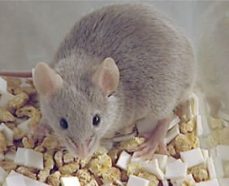Putting a Mouse on Pause
A gas known as hydrogen sulfide can put mice into a state resembling hibernation.
By Emily Sohn
Do you hate cold winters, or do you have a tough week coming up? Someday, you might be able to hibernate through them!
Scientists have found a way to bring breathing and heart rate nearly to a standstill in mice without killing them. It doesn’t even seem to harm the mice. This is the first time that scientists have induced a state of “suspended animation” in a mammal that doesn’t normally go into such a state on its own.
 |
|
|
| Oak Ridge National Laboratory |
Some animals regularly slow down their metabolic rates, or the speed at which their bodies function. Every day, for example, certain types of hummingbirds go into a state called torpor. Their heart rates drop, breathing slows, and body temperature plunges. Animals such as bears go into a similar type of hibernation for entire seasons.
Scientists would love to find a way to put people into a state of torpor. Suspended animation could offer protection after a heart attack or stroke, and it could help people survive while waiting for an organ transplant.
Previously, scientists had used a type of gas called hydrogen sulfide to induce torpor in yeast, worms, and flies. Mark Roth and his coworkers at the Fred Hutchinson Cancer Research Center in Seattle tried the same thing with common lab mice. These mice don’t normally show any type of hibernation behavior.
The researchers put mice in chambers containing low concentrations of hydrogen sulfide. The gas smells like rotten eggs. Within minutes of breathing it in, the mice stopped moving and seemed unconscious.
Over then next 6 hours, their breathing rate dropped from 120 breaths per minute to fewer than 10. Their body temperatures, usually a toasty 37 degrees C (98.6 degrees F), fell in some cases to as low as 11 degrees C (51.8 degrees F).
When the mice were able to breathe normal air again, their breathing rates and body temperatures went back up to normal. Tests showed no lasting damage.
The scientists speculate that hydrogen sulfide works by substituting for oxygen inside the parts of cells that produce energy. The study might help explain how natural hibernators kick-start their winter rest.
However, only future research will tell whether people can be put into a state resembling hibernation.—E. Sohn
Going Deeper:
Brownlee, Christen. 2005. Frozen in time: Gas puts mice metabolically on ice. Science News 167(April 23):261. Available at http://www.sciencenews.org/articles/20050423/fob5.asp .
You can learn more about hibernation at whyfiles.org/187hibernate/index.html (Why Files).







